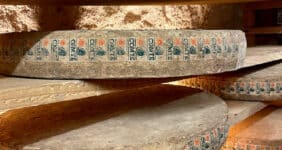Exploring Comte Cheese Through Its Origins and Taste
Comté cheese is a product of the picturesque French region of Franche-Comté in the Jura Mountains, near the border with Switzerland.
This semi-hard cheese, also known as mountain cheese, is renowned worldwide for its unique flavors and artisanal craftsmanship.
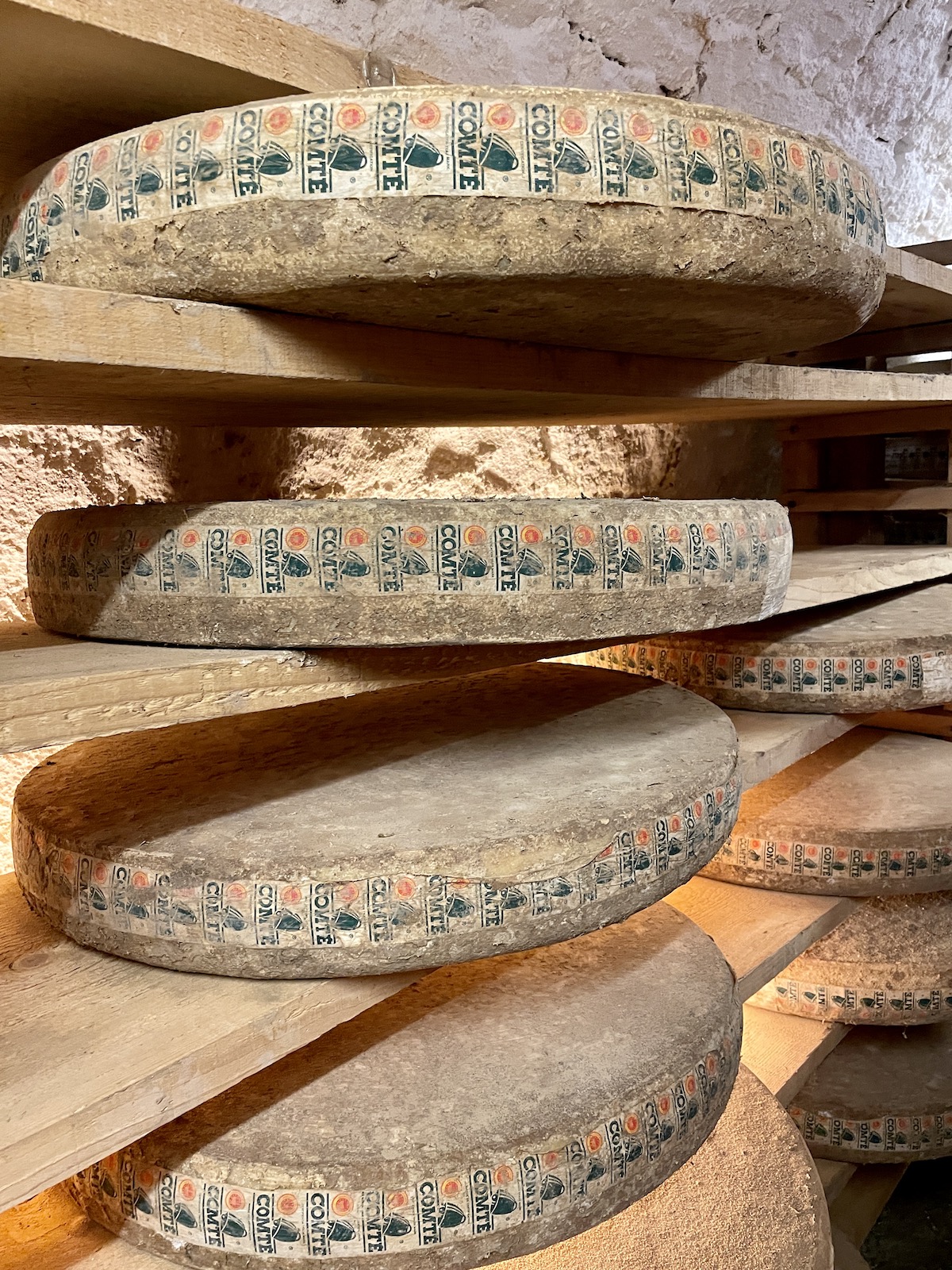
Comté is a French cheese with a rich history dating back centuries, and its distinctive taste and aroma have won the hearts of cheese enthusiasts everywhere.
Last month I was excited to explore the Jura massif region of eastern France to learn about and actually see Comte made, literally, from farm to table.
As much as I love Comté on its own, this Comté Cheese Flatbread is out of this world. Pair it with a Côtes du Rhône wine for the ultimate easy meal!
Table of Contents
The Story of Comté Cheese
At one time known as Gruyère de Comté, this cheese has a history that stretches back over eight centuries.
Its origin can be traced to the stunning valleys of the Franche-Comté region, located in the eastern part of France.
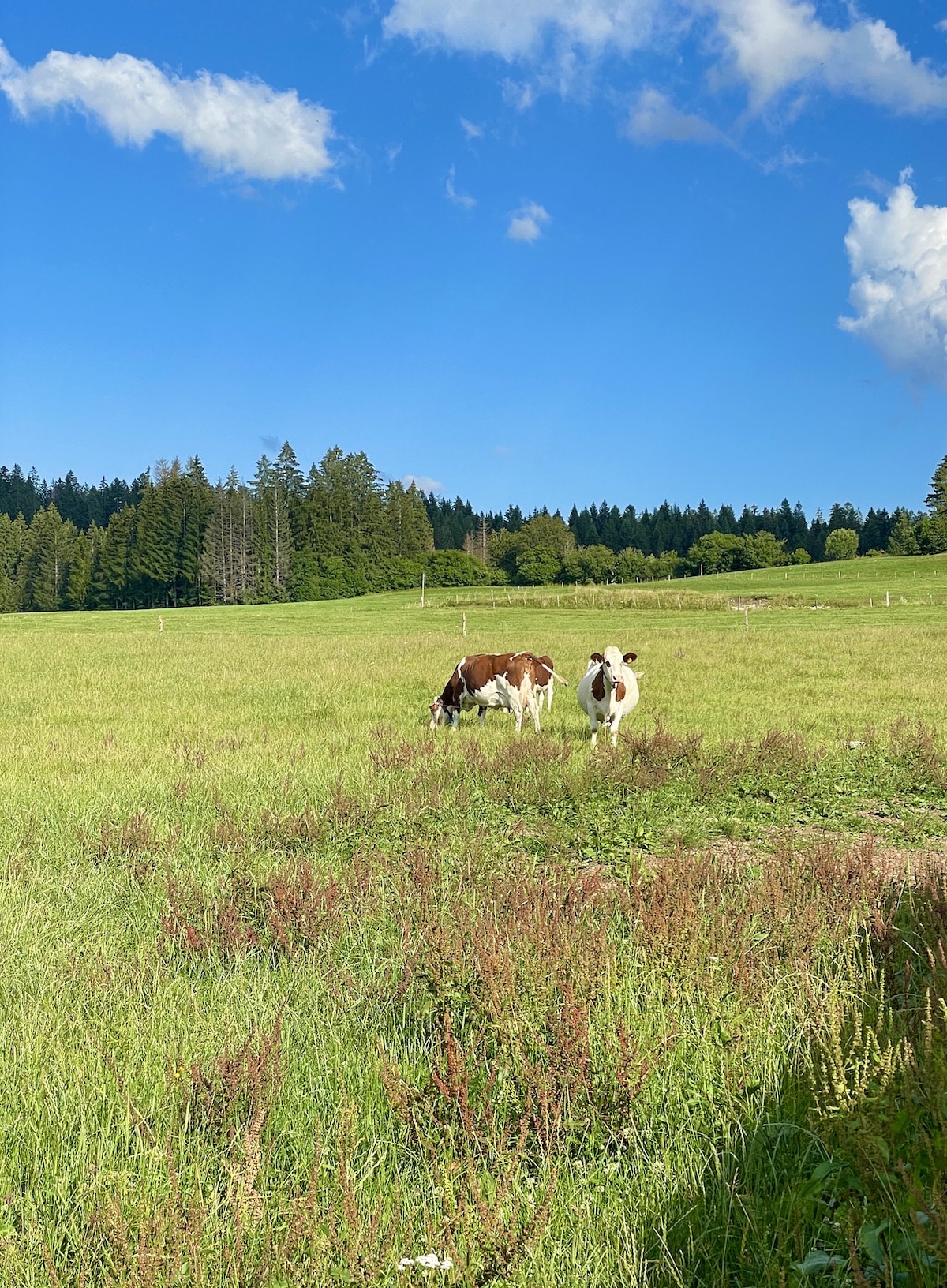
The region’s idyllic landscapes, marked by rolling hills, fertile pastures, and crystal-clear streams, contribute to the cheese’s exceptional quality.
The Jura Mountains is a beautiful part of the country, and the summer months are a great time to visit.
We spent a couple of days at Castel Damandre where I walked to this waterfall. It was a stunning hotel on beautiful grounds.

Comté Cheese Production Process
The traditional cheesemaking methods of producing Comté have been passed down from generation to generation, preserving the spirit and artistry that make this cheese truly special.
Made in the Jura Region
Made in the Jura region of France, Comté is a cow’s milk cheese made from unpasteurized milk.
Since Comté has a protected designation of origin status, there are official rules that must be followed.
Only Montbeliarde and French Simmental Cows
Most importantly, the milk comes only from Montbeliarde and French Simmental cows.
Local dairy farmers continue to use raw milk sourced from only those cows, ensuring the authenticity and originality of the production of Comté.
What’s different about these cows? For starters, they are considered to be the world’s most pampered.
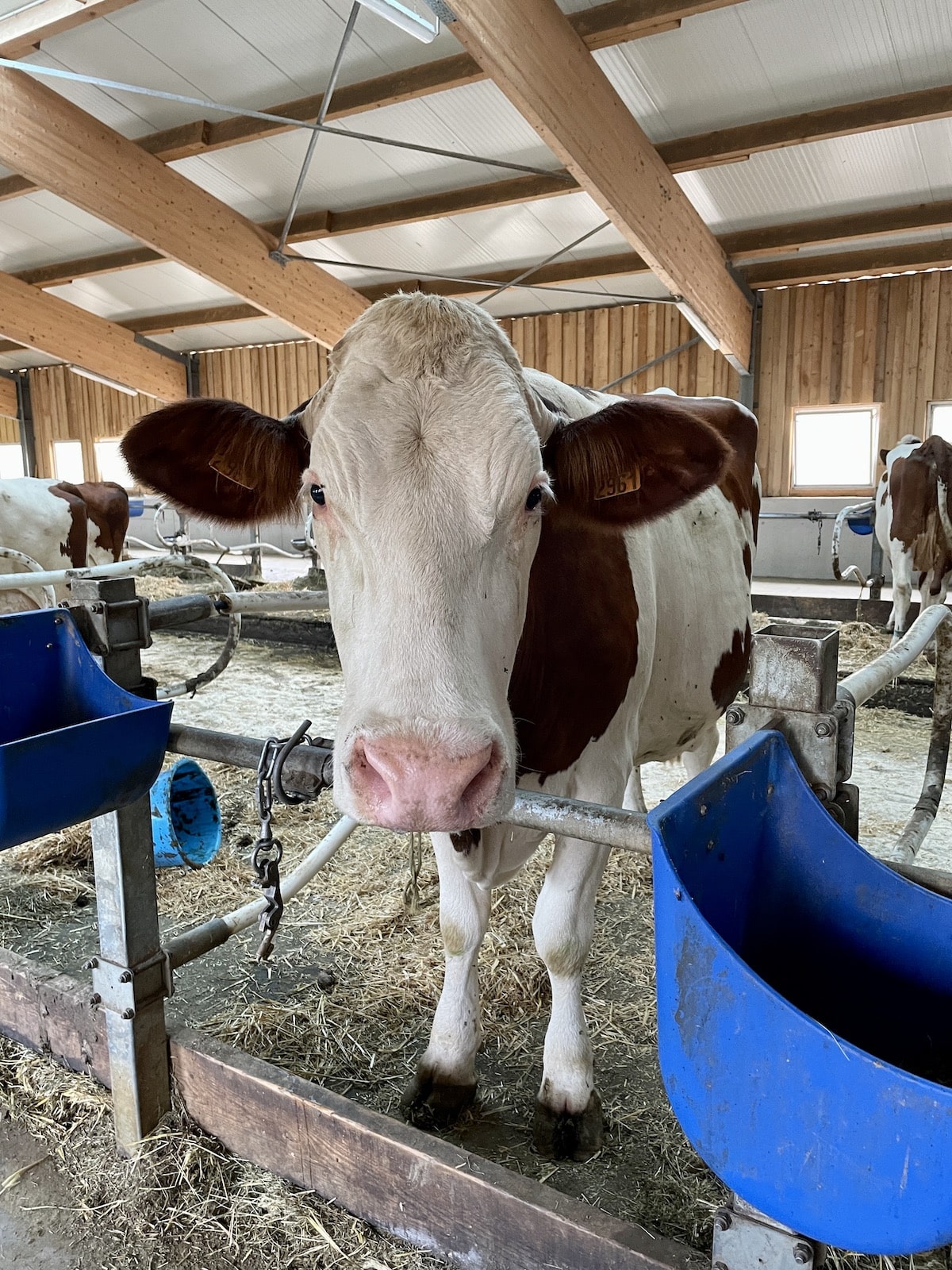
The farmers know each cow by name. Yes, they actually name each cow.
By law, Montbéliarde cows must have a hectare each, or 2 1/2 acres, to roam and graze on the fresh grass and flowers.
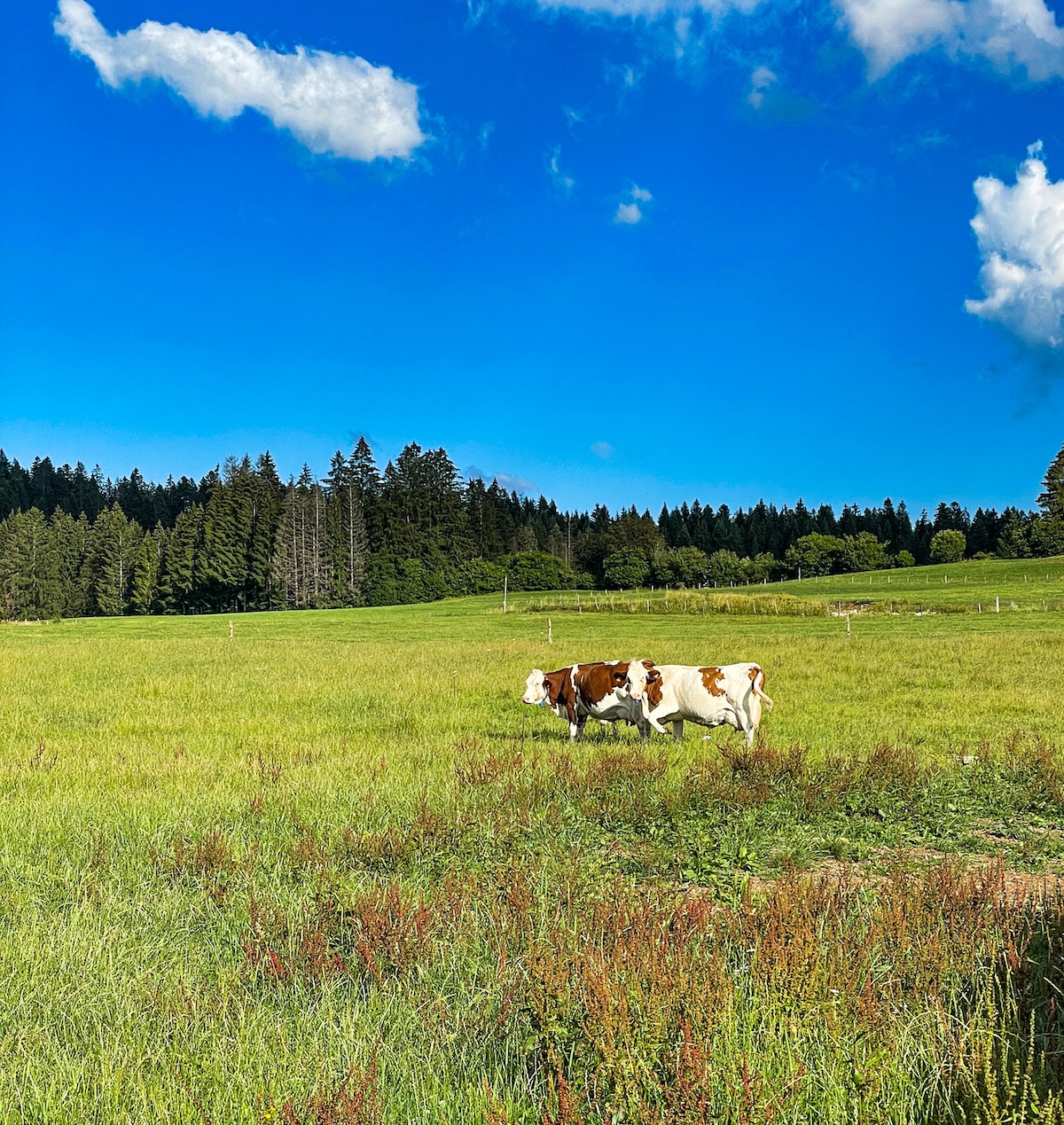
During winter, the cows eat hay that was grown on the farm, along with supplemental seeds and grain usually also produced on the farm.
The cow’s diet is to be kept as natural as possible, which is pretty easy in this region.
The Fruitieres
Crafting Comté French cheese is a labor-intensive process that demands patience, skill, and precision from the farmers to the fruitières to the affineurs.
400 litres of milk are needed to produce one wheel of Comté.
Local farmers collect the milk twice a day. The cows must be milked no more than 16 miles from the facility where the cheese will be made.
This ensures the milk is rich in microflora which helps create the flavor.
The collected milk must be meticulously poured into large copper vats for the cheese-making process.

The milk used is unpasteurized cow’s milk, central to the production as it contributes to the cheese’s unique mild flavour and aroma.
After adding natural whey starter cultures, the milk is heated and rennet is added to coagulate the liquid.
We looked on as this fruitiere checked the milk for curds. Have you ever seen how cheese is made?
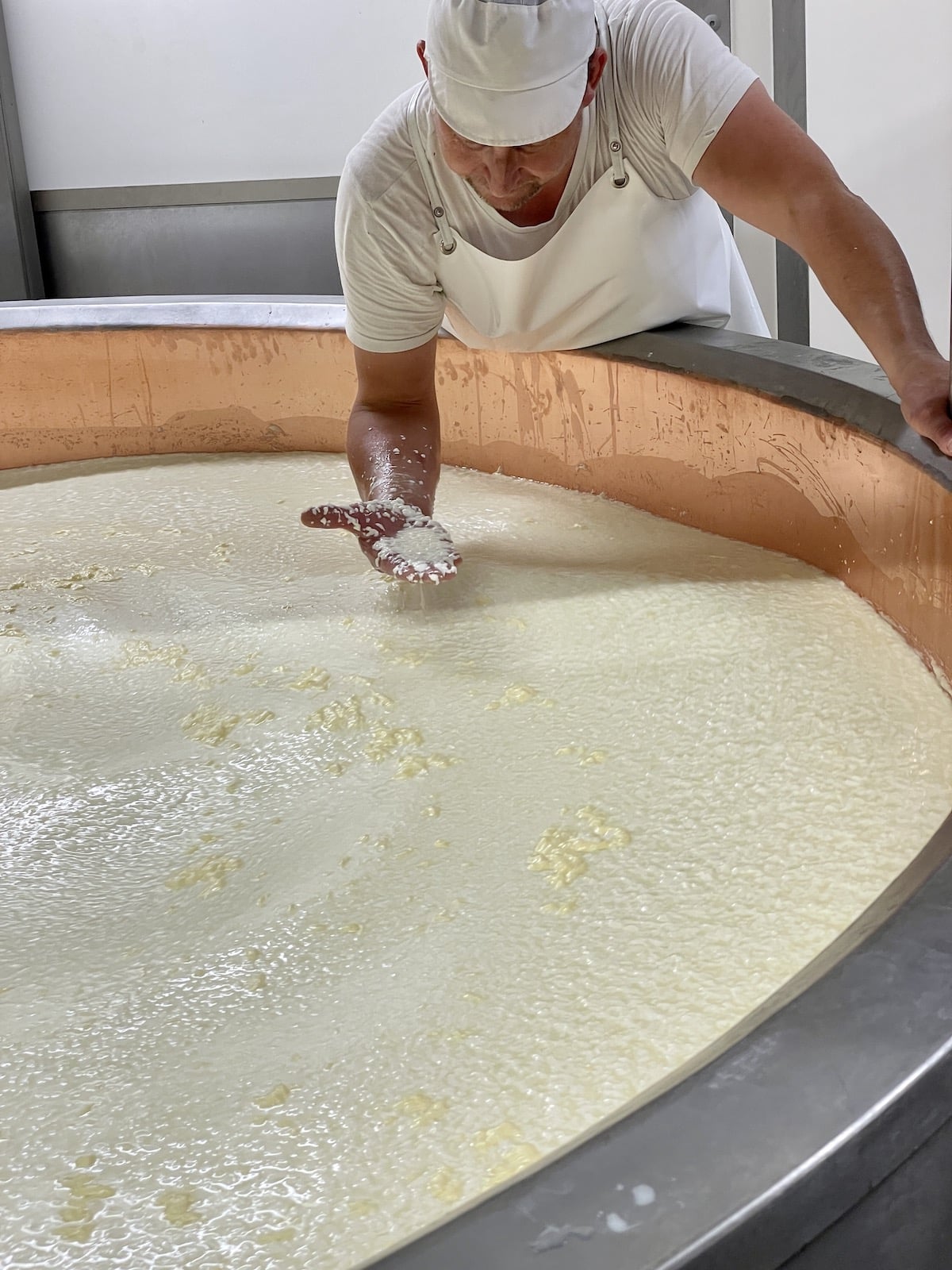
Watching first hand the way it’s made was fascinating.
The curds are then cut, stirred, and heated again to remove excess whey.
The cheese curds are pressed into a large mould, and the resulting wheels are soaked in brine to enhance their flavor and texture.
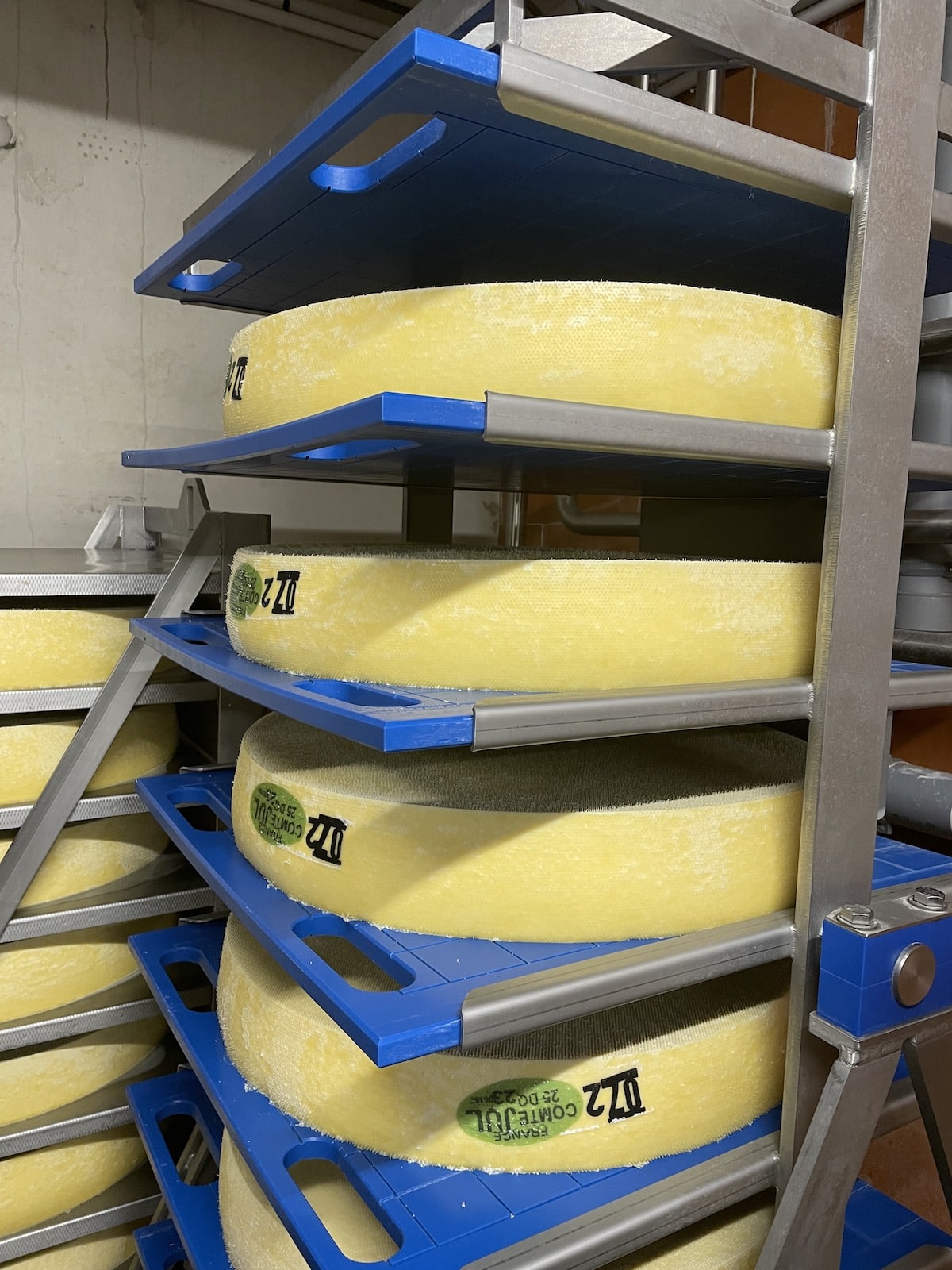
The Affineurs
Aged in large, well-ventilated cellars, Comté undergoes a maturation process that can last from several months to several years.
To see this part of the process, we were able to visit Fort Saint Antoine, the former fortress built to protect the Swiss border.

Like many French forts, it was abandoned. Thankfully, Marcel Petite stepped in and purchased the enormous stone building.
You might say Petite had a passion for Comté as he began his “slow maturing process” of this cheese in the 1960s.
Since Fort Saint Antoine became a maturing cellar, over 1 million wheels of Comté have been aged there!

During the maturation process, the expert affineur carefully nurtures each wheel, regularly turning, adding coarse sea salt to the outside, and brushing it to develop its flavors and textures.
Here he is using a small hammer to “ring” the cheese as you would ring a bell. From the tone, he can tell whether the cheese needs to continue to age or is ready for eating.
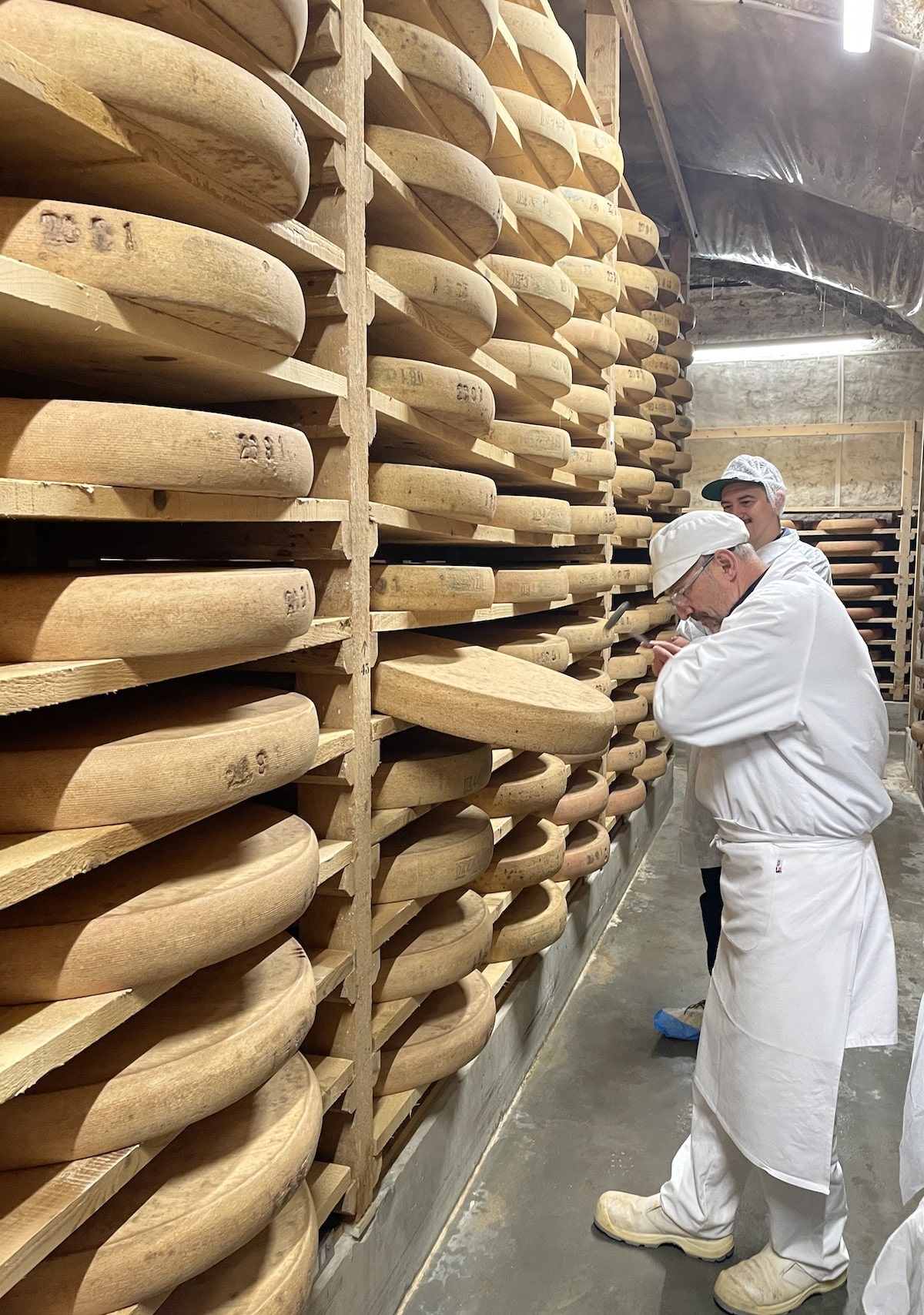
The affineur also will use a device to take a small piece of cheese out of the wheel to check the aroma, color, texture, and taste.
The plug can be placed back in the cheese for further aging.
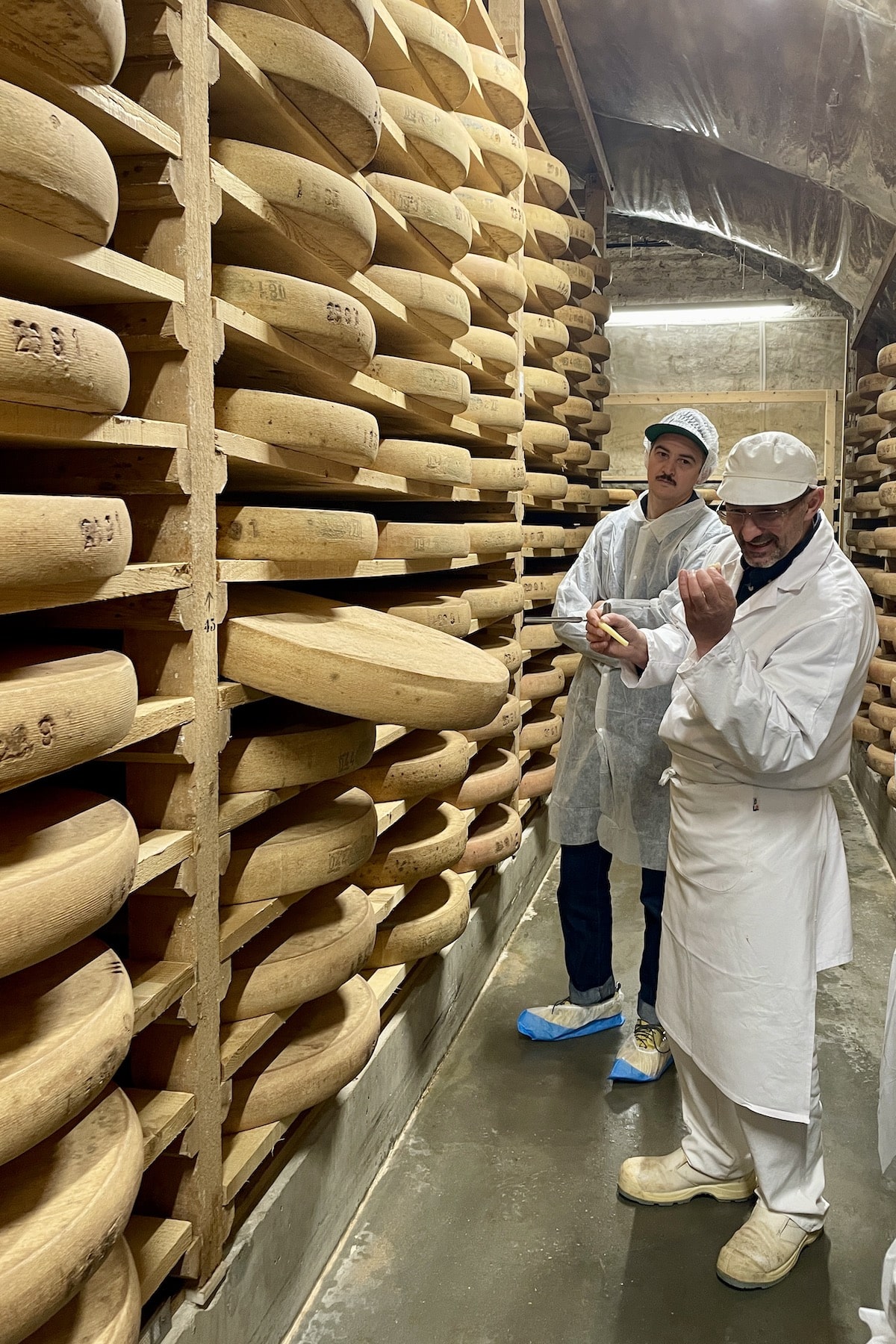
You can visit Fort Saint Antoine but you must have a reservation for a tour, which I highly recommend.
After our visit, we were able to taste a few of the cheeses that were aged there.
I was so excited to find Comte cheese here in Florida from this very cave last weekend at the Artisan Cheese Company in Sarasota.
If you plan to visit the region, you should also spend a little time at Maison du Comte to learn more about the history of Comte. They also offer a tasting.

Flavor Profile and Characteristics
Comté French cheese boasts a flavor profile with a unique taste as diverse as the landscapes of the Jura region.
Age of Comté Cheese
Depending on the age of a cheese, it exhibits a range of flavors, from fruity and nutty in its younger form to intensely savory and caramelized in its more mature versions.
A young Comté, aged for around 4 to 6 months, has a pale yellow color, is supple, and offers a mild and slightly sweet finish.
The young cheeses have hints of fresh fruit and a creamy texture.
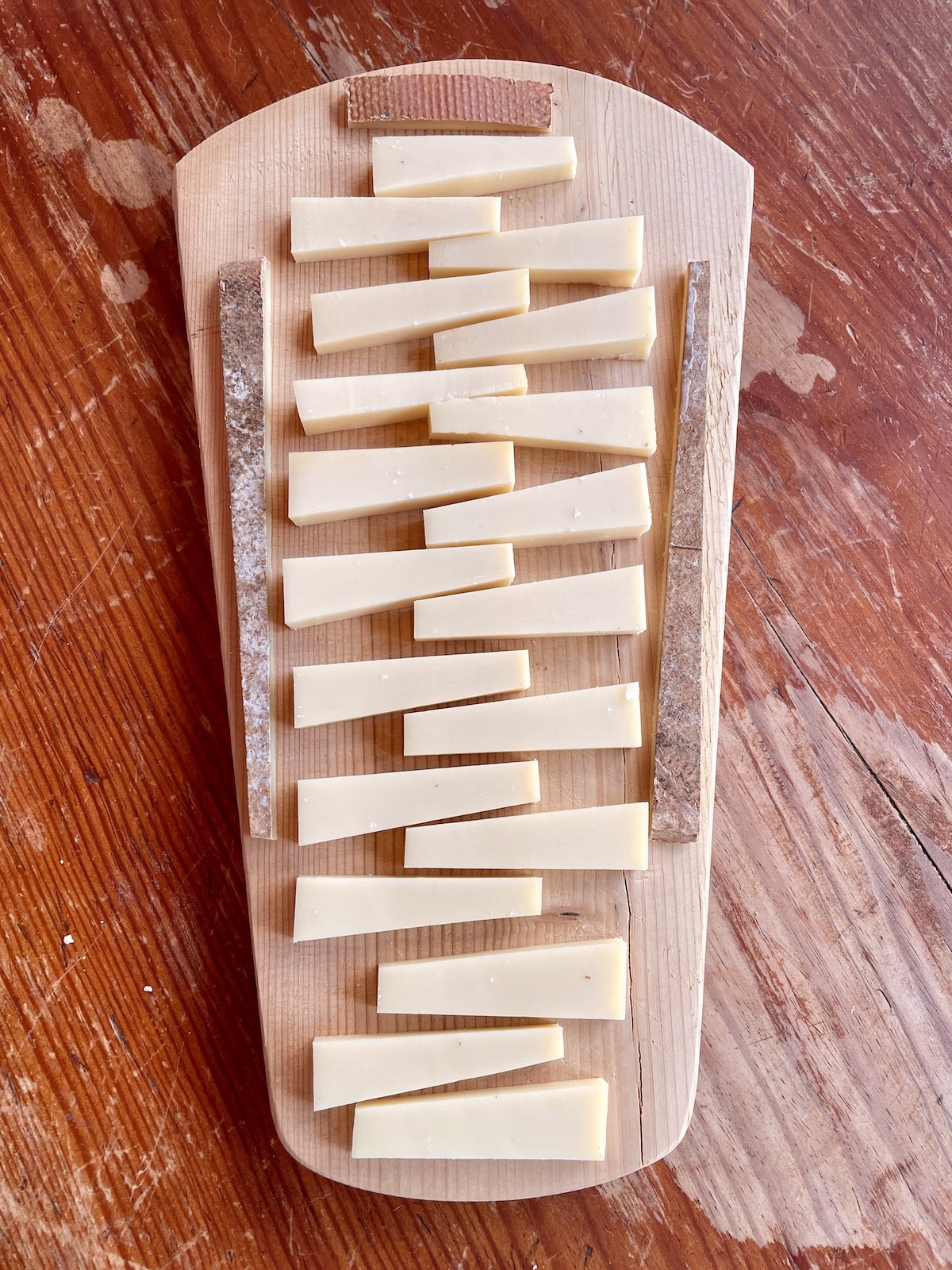
As it ages, the older Comté cheese gets a more pronounced nutty flavor reminiscent of toasted hazelnuts and brown butter, making it an excellent addition to a cheese platter or a simple yet indulgent sandwich.
For connoisseurs of aged cheeses, the Reserve Comté, matured for 12 to 24 months, or even longer, delivers a bold and complex flavor experience.
You’ll notice a more firm texture as this French cheese becomes drier and more crystalline.
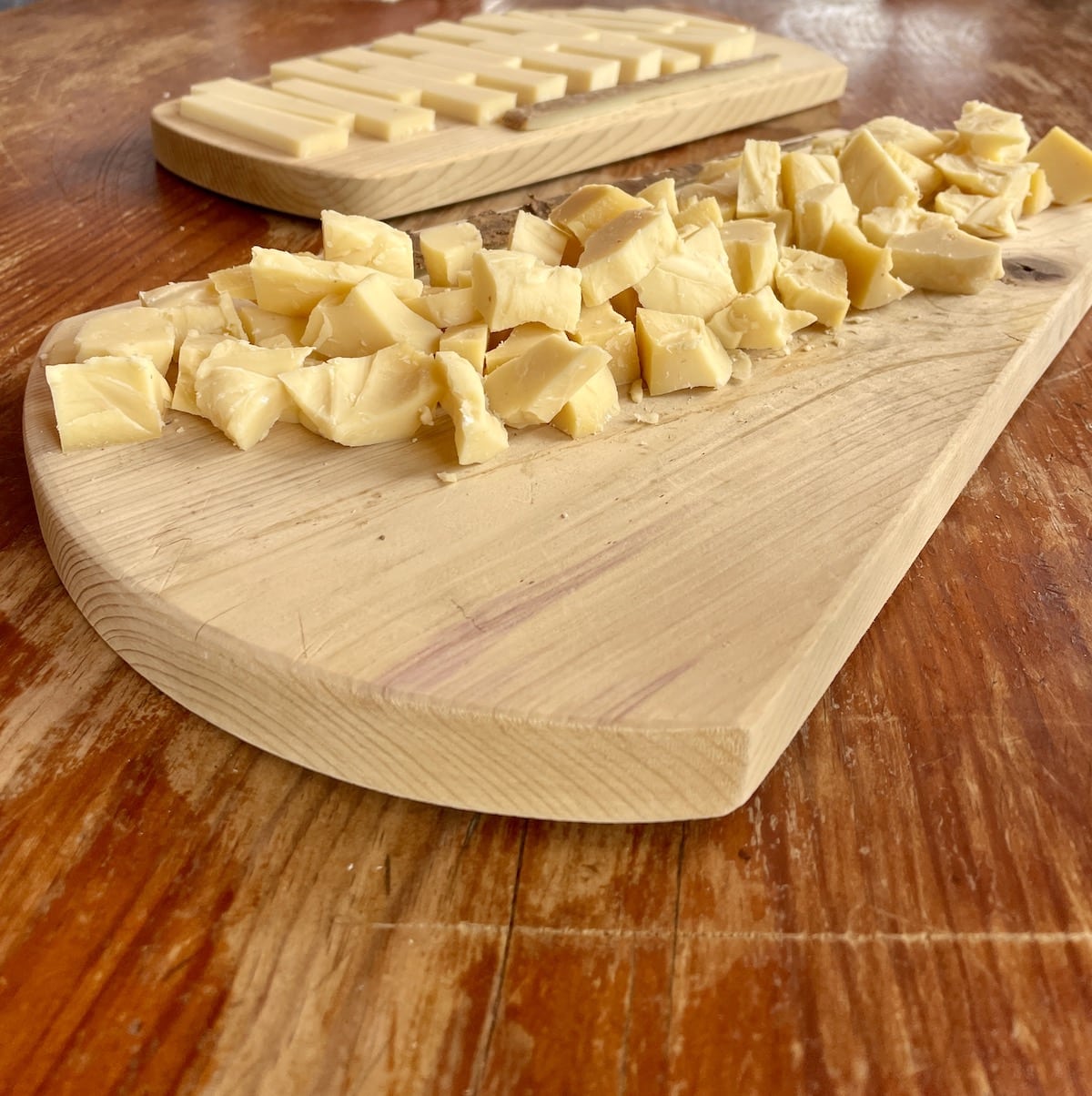
The flavors change a bit, to more intense notes of cooked caramel, spices, and earthiness.
Seasonal Flavor
You will also notice differences in the product made in summer and winter. Summer has an earthier flavor, whereas Winter Comté has a more delicate flavor.
Individual Palates
Of course, we all have different palates, so you’ll have to decide for yourself which is your favorite.
I love older cheeses, and it was no different with Comté for me. The more mature variety was my favorite.
Shortly after arriving in the area, we had a lunch including fondue. The flavor and aroma were incredible.
The dense texture is perfect for melting, which makes this cheese a favorite for fondue.
The day before leaving, we explored one of the finest cheese stores I’ve ever seen, Fromagerie Janin, in Champagnole.
Marc Janin, grandson of Robert who created this shop in 1960, showed us their aging cellars and led us in a tasting.
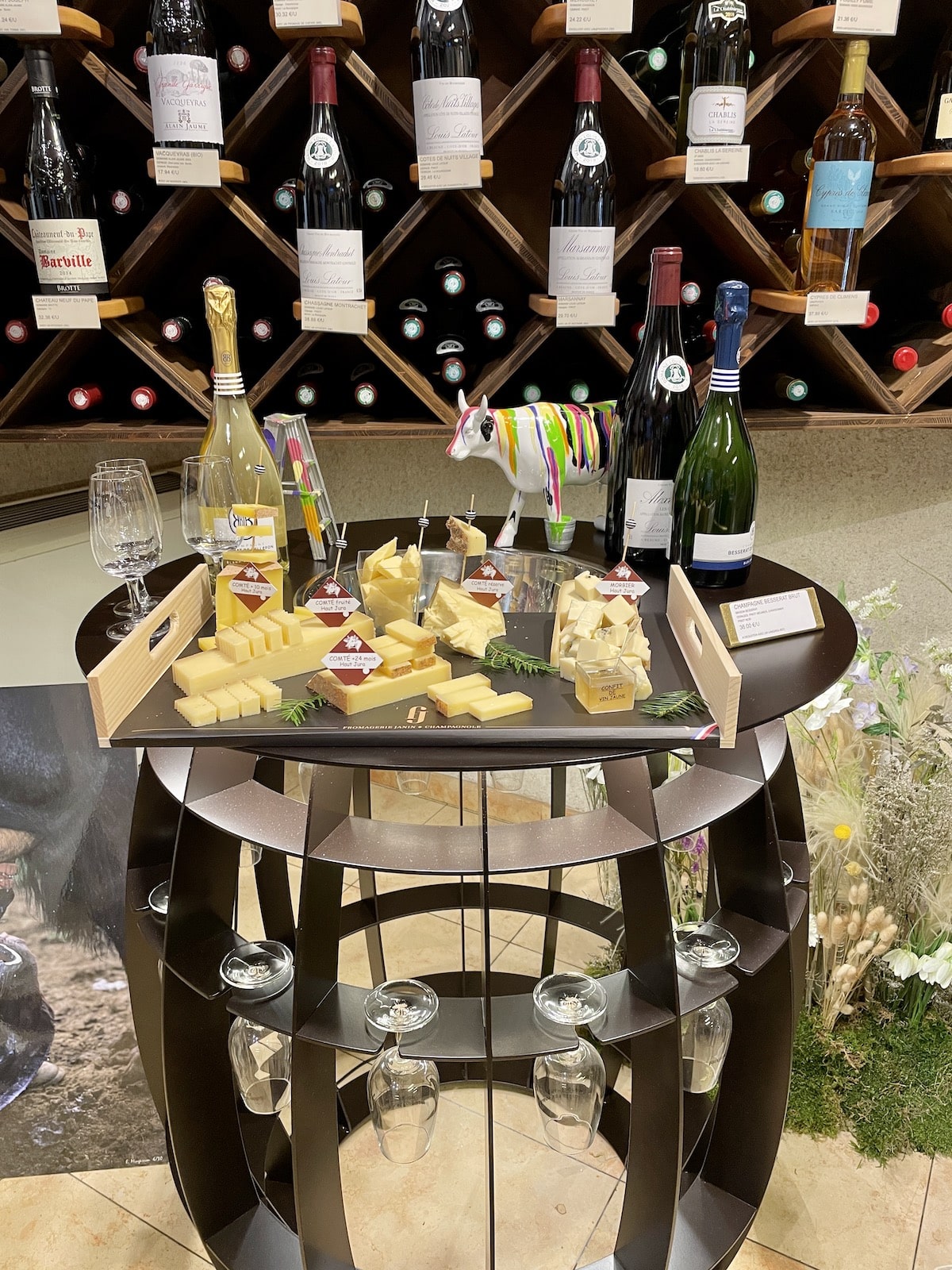
Comté Cheese Pairing Perfection
Comté’s versatility extends beyond savoring it on its own. Its complex flavors and texture make it an ideal companion for a wide array of culinary delights.
When grated, it adds a nutty depth to classic dishes like gratins and soufflés.
Melted over potatoes or pasta, this alpine cheese creates a velvety and irresistible sauce you just can’t get with other types of cheese.
French onion soup would be so good with this cheese!
Gruyere or Fontina are good substitutes if you can’t find the real thing. Aged cheddar or parmesan are decent replacements, but only if you must!
Moreover, this cheese harmonizes exquisitely with fruits, such as apples and pears, and pairs beautifully with full-bodied wines.
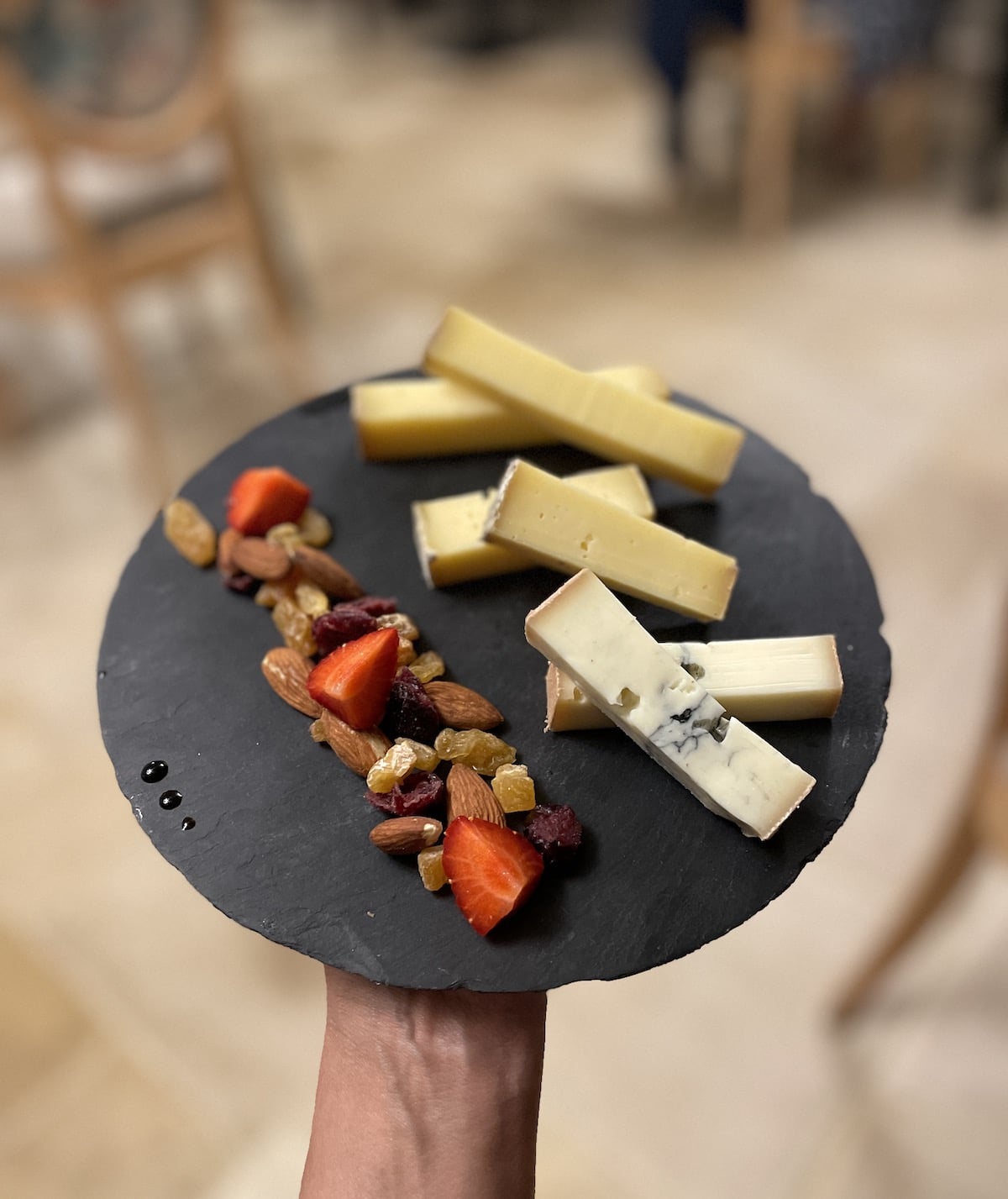
Serve it with fresh figs and a handful of walnuts for the perfect snack.
Each time we tasted a wheel of Comté while there, it was paired with Jura wines. White wines definitely pair well, but I’ve also enjoyed it with a Pinot Noir.
I’ve been adding Comte to charcuterie and cheese boards and we’re loving the flavors alongside fig jam and crusty bread.
Comté Cheese Loved Globally
Over the years, Comté has garnered a global fan base and earned recognition from cheese aficionados and chefs worldwide.
Its unique and authentic production process, along with its unparalleled taste, have led to its designation as an AOC (Appellation d’Origine Contrôlée) cheese.
This designation ensures that only cheese produced in Franche-Comté can bear the Comté name.
Exploring Comté, with its roots deeply entrenched in the cultural heritage of Franche-Comté, is like embarking on a sensory journey through time.
From the picturesque landscapes that nurture its source to the meticulous process of how Comté is made and aged, Comté continues to captivate tastebuds everywhere.
Whether you are a cheese connoisseur or a novice (like me!) simply eager to indulge in new flavor experiences, you really should explore Comte cheese for yourself.
Tips for Enjoying Comté Cheese
Serve this cheese at room temperature, best at 59º to 65º F.
This means if you’re serving it as part of a cheese platter or charcuterie board, you should take it out an hour or so before guest arrive to get it to the right temperature for the best flavor.
If the cheese was shrink-wrapped when purchased, re-wrap it in butcher paper or parchment once you’re home. This will help it to last longer.
This was a new tip for me and I’ll never store cheese in plastic wrap again as it can take on the taste of plastic.
If you plan to visit this region of France, you will fly in and out of Geneva, Switzerland. The Mercure Geneva Airport Hotel is lovely, super convenient, and has a wonderful breakfast.
FAQs
Comté is similar to Gruyere, but has its own flavor based on the region where it’s made.
Comté is made in the mountainous Jura region, which is near the border shared with Switzerland.
No, you should cut off the rind and not eat it.
More Cheese Goodness
How to Cut Cheese for a Charcuterie Board


